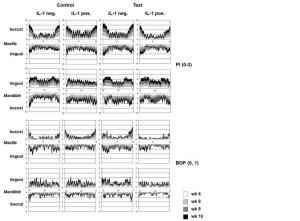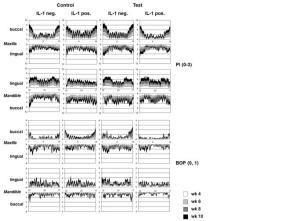Tagged: manual
Multilevel Modeling of Periodontal Data (VII)
Update below.
7 Ordered Categorical Response Models
In several chapters so far we have addressed modeling a binary response variable, for instance gingival bleeding upon periodontal probing, which has only two expressions, yes or no (or 1, 0). Many kinds of response variables are ordered categorical. For instance, the Silness & Löe plaque index, which assesses the amount of supragingival plaque at a certain tooth surface adjacent to the gingival margin, comprises clinically defined situations on a scale of scores from 0 to 3 (Table 7.1).
6 January 2015, 11:12 am.
Last modified January 6, 2015.
Update.
My MLwiN user manual using periodontal data has been completed but may be supplemented with further models if applicable.
Multilevel Modeling of Periodontal Data (VI)
Graphic display of results of a randomized clinical trial may lead to interesting hypotheses which might be tested with more sophisticated statistical methods. In a steady-state plaque environment, the topographical distribution of plaque, as assessed by Silness & Löe’s plaque index, in subjects using triclosan-containing test toothpaste for 6 weeks (after a 4 week preparatory phase) or fluoride control toothpaste is shown in the upper two panels. Results in IL-1 genotype-positive and -negative subjects are differentiated. While plaque distribution was largely comparable, consistent (mean plaque index scores of each examination were displayed on top of each other) and symmetric and followed a distinct pattern; bleeding on probing (a binary response), which is shown in the lower two panels, was not consistent, not symmetric and did not really follow a distinct pattern. Prevalence of bleeding on probing in the two most right panels (Il-1 genotype positive test toothpaste users) seems to differ from the other groups. The procedures described in the following chapter of my manual may indeed allow modeling of site-specific bleeding on probing.
6 Repeated Measures Models for Binary Outcomes
In Chapter 3, we had described simple, and quite complex, repeated measures time series models in which continuous outcomes, for instance, gingival thickness or gingival recession, were modeled over time after the implantation of a bio-resorbable membrane, when it had to be assumed that the responses were non-linear and non-monotonic.
In this chapter we want to model the binary outcome, bleeding on gingival probing, in subjects with mild plaque-induced gingival disease over time. While participants of the 1999 Workshop on Periodontal Diseases and Conditions had realized that most gingival inflammation is indeed dental plaque-induced, there seem to be numerous intrinsic and extrinsic factors which may modify the response. For instance, a common toothpaste compound, Triclosan, seems to dampen gingival inflammation in the presence of dental plaque (Müller et al. 2006). One may also ask whether the so-called interleukin-1 genotype, a combination of two single polymorphisms in the IL-1 gene, i.e. a haplotype, which had been associated with increased susceptibility for destructive periodontal disease (Kornman et al.1997) has a clinically discernable influence on the inflammatory response on dental plaque.
Mirrored from Periodontology – Matters arising.
Multilevel Modeling of Periodontal Data (VI)
 Graphic display of results of a randomized clinical trial may lead to interesting hypotheses which might be tested with more sophisticated statistical methods. In a steady-state plaque environment, the topographical distribution of plaque, as assessed by Silness & Löe’s plaque index, in subjects using triclosan-containing test toothpaste for 6 weeks (after a 4 week preparatory phase) or fluoride control toothpaste is shown in the upper two panels. Results in IL-1 genotype-positive and -negative subjects are differentiated. While plaque distribution was largely comparable, consistent (mean plaque index scores of each examination were displayed on top of each other) and symmetric and followed a distinct pattern; bleeding on probing (a binary response), which is shown in the lower two panels, was not consistent, not symmetric and did not really follow a distinct pattern. Prevalence of bleeding on probing in the two most right panels (Il-1 genotype positive test toothpaste users) seems to differ from the other groups. The procedures described in the following chapter of my manual may indeed allow modeling of site-specific bleeding on probing.
Graphic display of results of a randomized clinical trial may lead to interesting hypotheses which might be tested with more sophisticated statistical methods. In a steady-state plaque environment, the topographical distribution of plaque, as assessed by Silness & Löe’s plaque index, in subjects using triclosan-containing test toothpaste for 6 weeks (after a 4 week preparatory phase) or fluoride control toothpaste is shown in the upper two panels. Results in IL-1 genotype-positive and -negative subjects are differentiated. While plaque distribution was largely comparable, consistent (mean plaque index scores of each examination were displayed on top of each other) and symmetric and followed a distinct pattern; bleeding on probing (a binary response), which is shown in the lower two panels, was not consistent, not symmetric and did not really follow a distinct pattern. Prevalence of bleeding on probing in the two most right panels (Il-1 genotype positive test toothpaste users) seems to differ from the other groups. The procedures described in the following chapter of my manual may indeed allow modeling of site-specific bleeding on probing.
6 Repeated Measures Models for Binary Outcomes
In Chapter 3, we had described simple, and quite complex, repeated measures time series models in which continuous outcomes, for instance, gingival thickness or gingival recession, were modeled over time after the implantation of a bio-resorbable membrane, when it had to be assumed that the responses were non-linear and non-monotonic.
In this chapter we want to model the binary outcome, bleeding on gingival probing, in subjects with mild plaque-induced gingival disease over time. While participants of the 1999 Workshop on Periodontal Diseases and Conditions had realized that most gingival inflammation is indeed dental plaque-induced, there seem to be numerous intrinsic and extrinsic factors which may modify the response. For instance, a common toothpaste compound, Triclosan, seems to dampen gingival inflammation in the presence of dental plaque (Müller et al. 2006). One may also ask whether the so-called interleukin-1 genotype, a combination of two single polymorphisms in the IL-1 gene, i.e. a haplotype, which had been associated with increased susceptibility for destructive periodontal disease (Kornman et al.1997) has a clinically discernable influence on the inflammatory response on dental plaque.
22 December 2014 @ 1:10 pm.
Last modified December 22, 2014.
Multilevel Modeling of Periodontal Data (IV)
The (published) picture above had been created based on fixed estimates of a multivariate multilevel time series model of gingival dimensions after the implantation of a bioresorbable membrane for surgical root coverage. One may intuitively compare the multilevel model with a microscope here since raw data or presentation of means and standard deviations would hardly give a similarly elegant impression of what is actually going on after implantation of a membrane for guided tissue regeneration.
The fourth chapter of my new MLwiN manual using own data has been proofread and those who are still interested in “happy multilevel modeling” are encouraged to click here.
4 Multivariate Response Models
In the previous chapter, increasingly complex time series models have been set up in order to model gingival thickness, its width, the position of the mucogingival border relative to the cemento-enamel junction, and gingival recession after surgical implantation of a bio-resorbable membrane for guided tissue regeneration for the treatment of gingival recession. While some of these variables, such as thickness and width of gingiva might be positively related, others are not, for example gingival thickness and recession. Mucosal thickness had been measured at three locations: at the gingival margin, as well as at and below the mucogingival border (Müller et al. 2000d). In order to create general predictions of alterations of gingival dimensions after surgery, one single model would be preferred which might include mucosal thickness as measured at different locations as three different responses.
Multivariate response data are most conveniently incorporated into a multilevel model by creating a lower level below the original level 1 units. This will define the multivariate structure. Here we want to set up a 4-level model with multivariate responses (level 1) measured at different occasions (level 2) nested in higher-level units, i.e. teeth (level 3) and patients (level 4).
3 October 2014 @ 8:47 am.
Last modified October 3, 2014.
Multilevel Modeling of Periodontal Data (III)
After a long hiatus due to other projects, final exams and, well, some vacation, the next chapter of my multilevel modeling manual was overdue, but here it comes.
MULTILEVEL MODELING OF PERIODONTAL DATA
Manual version 2014.1
Hans-Peter Müller
3 Time Series Models
In the two previous chapters, observations have been modeled which had been made at teeth which were nested in subjects. Now, consider that observations had been repeated in a longitudinal way, for example after therapy. For that purpose, we want to define a lower level (one) as repeated measures, or occasion, while teeth and subjects would define levels two and three, respectively.
Consider, for instance changes of the entire gingival unit after the implantation of a bio-resorbable membrane for surgical root coverage employing the principle of guided tissue regeneration. Apart from achievable root coverage, the implantation of the membrane and concomitant coronal advancement of the mucoperiosteal flap leads to an immediate increase in thickness of gingiva and later in width of keratinized tissue. Of course, the mucogingival border is displaced but may re-establish itself later in its original position. Note that these alterations at teeth are non-linear and, since wound healing proceeds and regenerated tissue matures over time, non-monotonic (see example (C) in Fig. 13.1 in Rasbash et al. 2012). And they certainly depend on the subject. So, we have a three-level structure with a sample of subjects in which we study gingival dimensions at teeth, which have been surgically treated, over time. The data had been analyzed by multilevel modeling in some detail by Müller (2008).
In this chapter we want to introduce the data set which had been created in a longitudinal study (Müller et al. 2000d) and set up several multilevel models further elaborating the basic time series model.
3.1 Repeated Measures Data on Gingival Dimensions after Surgical Root Coverage
The data set consists of observations which have been made in 14 patients who had presented with a large variety of recession types at altogether 31 teeth. They had been treated according to the principles of guided tissue regeneration employing a bio-resorbable membrane. Surgical root coverage consisted, after periosteal dissection, of a coronally advanced flap which was secured with sling sutures. Several preoperative clinical parameters and intrasurgical observations were assessed. Patients were followed up for 1 year, and re-examinations of the clinical situation were carried out after 3, 6, 9 and 12 months.
14 August 2014 @ 8:01 am.
Last modified August 14, 2014.


